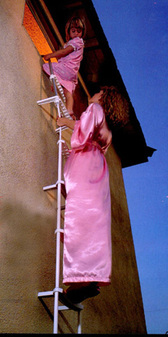HOME FIRE ESCAPE PLANNING & PRACTICE
Developing and practicing a home fire escape plan that everyone understands can mean the difference between life and death. Fire can grow and spread through your home very quickly. It's important that you be prepared to react as soon as the smoke alarm sounds.
Facts &Figures
Source:
Harris Interactive Survey, Fall 2004, conducted for NFPA (PDF, 759 KB), and NFPA?s Fire Loss in the United States During 2004 - Abridged report(PDF, 89 KB).
Safety tips
These tips can help you put together and practice an effective home fire escape plan.
Facts &Figures
- Only one-fifth to one-fourth of households (23%) have actually developed and practiced a home fire escape plan to ensure they could escape quickly and safely.
- In 2004, there were an estimated 395,500 reported home structure fires and 3,190 associated civilian deaths in the United States.
- One-third of American households who made an estimate thought they would have at least 6 minutes before a fire in their home would become life-threatening. The time available is often less. And only 8% said their first thought on hearing a smoke alarm would be to get out!
Source:
Harris Interactive Survey, Fall 2004, conducted for NFPA (PDF, 759 KB), and NFPA?s Fire Loss in the United States During 2004 - Abridged report(PDF, 89 KB).
Safety tips
These tips can help you put together and practice an effective home fire escape plan.
- Pull together everyone in your household and make a plan. Draw a floor plan of your home
(PDF, 107 KB) showing two ways out of each room, including windows. Don't forget to mark the location of each smoke alarm. - Test all smoke alarms monthly to ensure that they work. Replace batteries as needed.
- Make sure that everyone understands the escape plan and recognizes the sound of the smoke alarm. Are the escape routes clear? Can doors and windows be opened easily?
- If windows or doors in your home have security bars, make sure that the bars have quick- release mechanisms on the inside so that they can be opened immediately in an emergency. Quick-release mechanisms won't compromise your security but they will increase your chances of safely escaping a home fire.
- Practice the escape plan at least twice a year, making sure that everyone is involved from kids to grandparents. Allow children to master fire escape planning and practice before holding a fire drill at night when they are sleeping. The objective is to practice, not to frighten, so telling children there will be a drill before they go to bed can be as effective as a surprise drill. If children or others do not readily waken to the sound of the smoke alarm, or if there are infants or family members with mobility limitations, make sure that someone is assigned
to assist them in fire drill and in the event of an emergency. - Agree on an outside meeting place where everyone can meet after they've escaped. Remember to get out first, then call for help. Never go back inside until the fire department gives the OK.
- Have everyone memorize the emergency phone number of the fire department. That way
any member of the household can call from a cellular phone or a neighbor's home. - Be fully prepared for a real fire: when a smoke alarm sounds, get out immediately. And once you're out, stay out leave the firefighting to the professionals!
- If you live in an apartment building, make sure that you're familiar with the building's evacuation plan. In case of a fire, use the stairs, never the elevator.
- Tell guests or visitors to your home about your family's fire escape plan. When visiting other people's homes, ask about their escape plan. If they don't have a plan in place, offer to help them make one.

